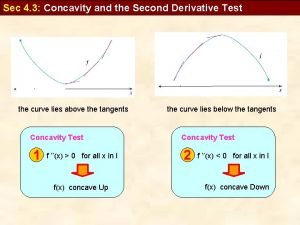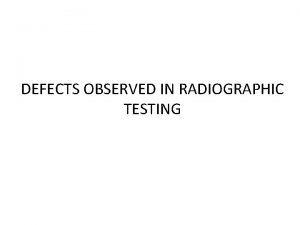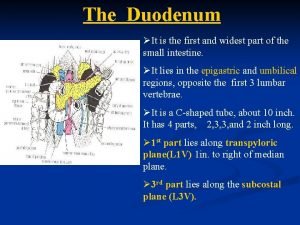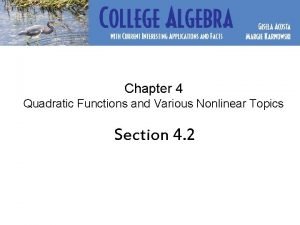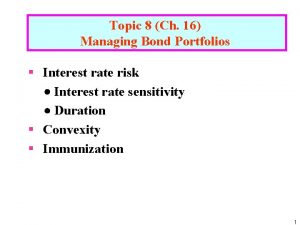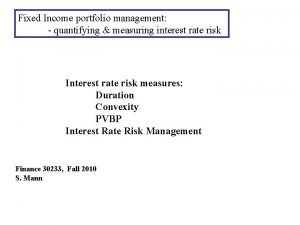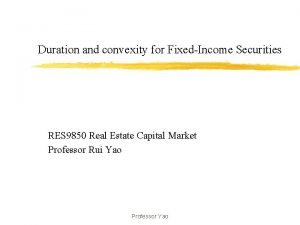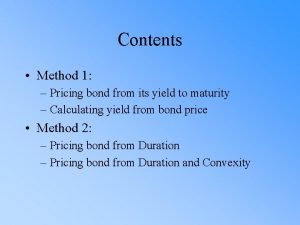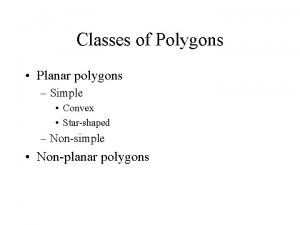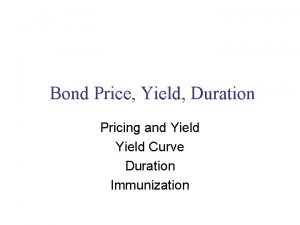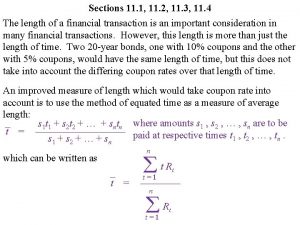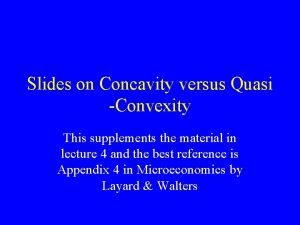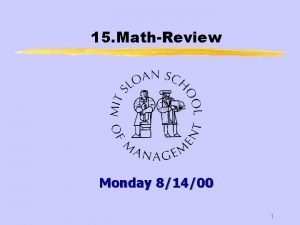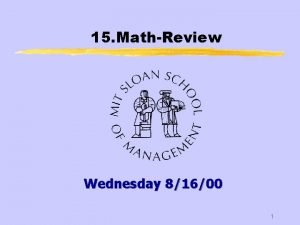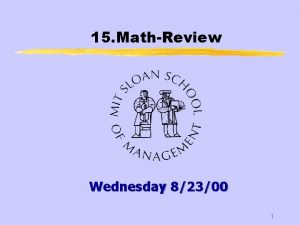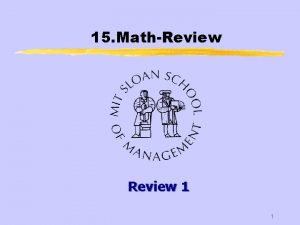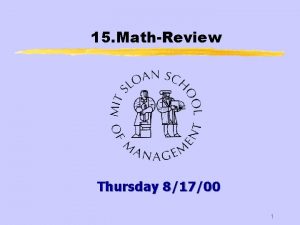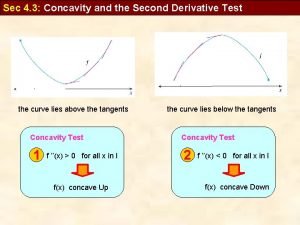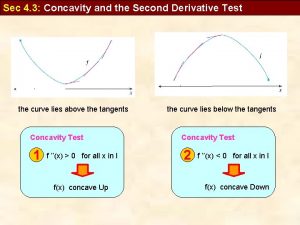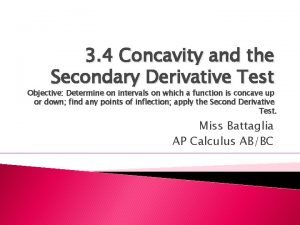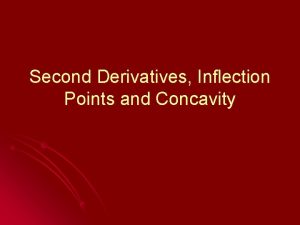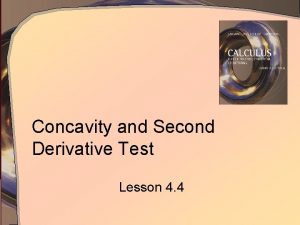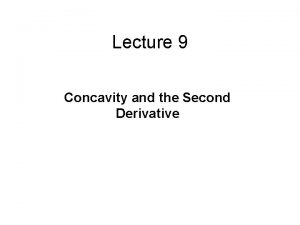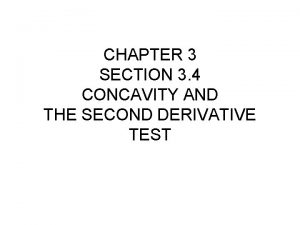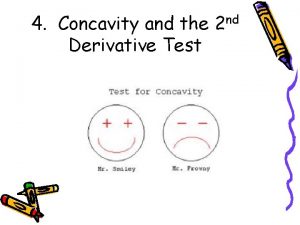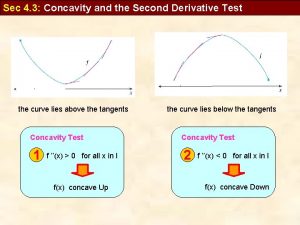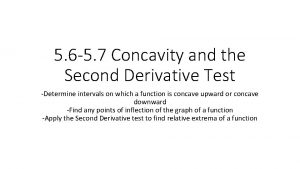15 MathReview Tuesday 81500 1 Convexity and Concavity

![Convexity and Concavity z Consider the function f(x)=x 2 over the interval [-1, 1]. Convexity and Concavity z Consider the function f(x)=x 2 over the interval [-1, 1].](https://slidetodoc.com/presentation_image/f3aad12ddc46e46e847b8a5c050f79c7/image-2.jpg)
















![Stationary Points z Example: y Consider the function defined over all x [-3, 3], Stationary Points z Example: y Consider the function defined over all x [-3, 3],](https://slidetodoc.com/presentation_image/f3aad12ddc46e46e847b8a5c050f79c7/image-19.jpg)




- Slides: 23

15. Math-Review Tuesday 8/15/00 1
![Convexity and Concavity z Consider the function fxx 2 over the interval 1 1 Convexity and Concavity z Consider the function f(x)=x 2 over the interval [-1, 1].](https://slidetodoc.com/presentation_image/f3aad12ddc46e46e847b8a5c050f79c7/image-2.jpg)
Convexity and Concavity z Consider the function f(x)=x 2 over the interval [-1, 1]. Is this function convex or concave? Prove it. 15. Math-Review 2

Differentiation z The derivative y The derivative of a function at a point is the instantaneous slope of the function at that point. This is, the slope of the tangent line to the function at that point. y Notation: for a function y = f(x), the derivative of f with respect to x can be written as: 15. Math-Review 3

Differentiation z This graphically: y y= (x-t)f’(t)+f(t) y= (x-s)f’(s)+f(s) s 15. Math-Review y=f(x) f(s) t x 4

Differentiation z Rules of differentiation: (a) f(x) = k (b) f(x) = ax (c) f(x) = xn => f’(x) = 0 => f’(x) = a => f’(x) = nxn– 1 y Example: f(x) = x 5 f(x) = x 2/3 f(x) = x– 2/5 15. Math-Review 5

Differentiation z Rules of differentiation: (d) f(x) = g(x) + h(x) (e) f(x) = kg(x) (f) f(x) = g(x)n => f’(x) = g’(x) + h’(x) => f’(x) = kg’(x) => f’(x) = n g’(x)g(x)n– 1 y Inverse rule as a special case of this: y Example: f(x) = 3 x 2 f(x) = 3 x 3 – 4 x 2 + 6 x – 20 f(x) = (3– 7 x)– 3 15. Math-Review 6

Differentiation z More rules of differentiation: (g) f(x) = g(x)h(x) => f’(x) = g’(x)h(x)+ g(x)h’(x) (h) (i) f(x) = g(h(x)) => f’(x) = g’(h(x))h’(x) y Inverse rule as a special case of this: y Example: product, quotient and chain for the following: g(x) = x+2, h(x) = 3 x 2 g(x) = 3 x 2 + 2, h(x) = 2 x – 5 g(x) = 6 x 2, h(x) = 2 x + 1 g(x) = 3 x, h(x) = 7 x 2 – 10 g(x) = 3 x + 6, h(x) = (2 x 2 + 5). (3 x – 2) 15. Math-Review 7

Differentiation z Even more rules of differentiation: (j) f(x) = ax => f’(x) = ln(a)ax (k) f(x) = ln(x) => f’(x) = 1/x y Example: f(x) = ex f(x) = ln(3 x 3 + 2 x+6) f(x) = ln(x-3) 15. Math-Review 8

Differentiation z Example: logs, rates and ratios: y For the following examples we will consider y a function of x, ( y(x) ). y Compute: y For this last example find an expression in terms of rates of changes of x and y. 15. Math-Review 9

Differentiation z A non-linear model of the demand for door knobs, relating the quantity Q to the sales price P was estimated by our sales team as Q = e 9. 1 P-0. 10 z Derive an expression for the rate of change in quantity to the rate of change in price. 15. Math-Review 10

Differentiation z To differentiate is a trade…. 15. Math-Review 11

Differentiation z Higher order derivatives: y The second derivative of f(x) is the derivative of f’(x). It is the rate of change of function f’(x). y Notation, for a function y=f(x), the second order derivative with respect to x can be written as: y Higher order derivatives are defined analogously. y Example: Second order derivative of 15. Math-Review f(x) = 3 x 2 -12 x +6 f(x) = x 3/4 -x 3/2 +5 x 12

Differentiation z Application of f’’(x) y We have that f’(t) f’(t+ ) y This means that the rate of change of f’(x) around t is negative. y f’’(t) 0 slope=f’(t + ) slope=f’(t) y=f(x) t t+ y We also note that around t, f is a concave function. z Therefore: y f’’(t) 0 is equivalent to f a concave function around t. y f’’(t) 0 is equivalent to f a convex function around t. 15. Math-Review 13

Differentiation z Partial derivatives: y For functions of more than one variable, f(x, y), the rate of change with respect to one variable is given by the partial derivative. y The derivative with respect to x is noted: y The derivative with respect to y is noted: y Example: Compute partial derivatives w/r to x and y. f(x, y) = 2 x + 4 y 2 + 3 xy f(x, y) = (3 x – 7)(4 x 2 – 3 y 3) f(x, y) = exy 15. Math-Review 14

Stationary Points z Maximum y A point x is a local maximum of f, if for every point y ‘close enough’ to x, f(x) > f(y). y A point x is a global maximum of f, if f(x) > f(y) for any point y in the domain. y In general, if x is a local maximum, we have that: f’(x)=0, and f’’(x)<0. Global Maximum y Graphically: 15. Math-Review Local Maximum 15

Stationary Points z Minimum y A point x is a local minimum of f, if for every point y ‘close enough’ to x, f(x) < f(y). y A point x is a global minimum of f, if f(x) < f(y) for any point y in the domain. y In general, if x is a local minimum, we have that: f’(x)=0, and f’’(x)>0. y Graphically: Local Minimum Global Minimum 15. Math-Review 16

Stationary Points z Example: y Consider the function defined over all x>0, f(x) = x - ln(x). y Find any local or global minimum or maximum points. What type are they? 15. Math-Review 17

Stationary Points z Consider the following example: y The function is only defined in [a 1, a 4]. y Points a 1 and a 3 are maximums. y Points a 2 and a 4 are minimums. y And we have: a 1 a 2 a 3 a 4 f’(a 1) < 0 and f’’ (a 1) ? 0 f’(a 2) = 0 and f’’ (a 2) 0 f’(a 3) = 0 and f’’ (a 3) 0 f’(a 4) < 0 and f’’ (a 4) ? 0 y The problem arises in points that are in the boundary of the domain. 15. Math-Review 18
![Stationary Points z Example y Consider the function defined over all x 3 3 Stationary Points z Example: y Consider the function defined over all x [-3, 3],](https://slidetodoc.com/presentation_image/f3aad12ddc46e46e847b8a5c050f79c7/image-19.jpg)
Stationary Points z Example: y Consider the function defined over all x [-3, 3], f(x) = x 3 -3 x+2. y Find any local or global minimum or maximum points. What type are they? 15. Math-Review 19

Stationary Points z Points of Inflection. y Is where the slope of f shifts from increasing to decreasing or vice versa. y Or where the function changes from convex to concave or v. v. y In other words f’’(x) = 0!! Points of Inflection 15. Math-Review Points of Inflection 20

Stationary Points z Finding Stationary Points y Given f(x), find f’(x) and f”(x). y Solve for x in f’(x) = 0. y Substitute the solution(s) into f”(x). x. If f”(x) 0, x is a local minimum. x. If f”(x) 0, x is a local maximum. x. If f”(x) = 0, x is likely a point of inflection. y Example: f(x) = x 2 – 8 x + 26 f(x) = x 3 + 4 x 2 + 4 x f(x) = 2/3 x 3 – 10 x 2 + 42 x – 3 15. Math-Review 21

Tough examples to kill time z Application of derivative: L’Hopital rule. z Use this rule to find a limit for f(x)=g(x)/h(x): 15. Math-Review 22

Tough examples to kill time z Example: y Let us consider the function Obtain a sketch of this function using all the information about stationary points you can obtain. y Sketch the function Hint: for this we will need to know that the ex ‘beats’ any polynomial for very large and very small x. 15. Math-Review 23
 Weld reinforcement definition
Weld reinforcement definition Sec derivative
Sec derivative Test for concavity
Test for concavity Internal undercut radiograph
Internal undercut radiograph Concavity of duodenum
Concavity of duodenum Concave parabola
Concave parabola Formula convexity
Formula convexity What is pvbp
What is pvbp Convexity duration formula
Convexity duration formula Convexity adjustment formula
Convexity adjustment formula Convexity duration formula
Convexity duration formula Convex polygon examples
Convex polygon examples Bond equivalent yield formula
Bond equivalent yield formula Crest of convexity
Crest of convexity Convexity equation
Convexity equation Convexity anatomy
Convexity anatomy Convexity obligacji
Convexity obligacji Tuesday morning prayer
Tuesday morning prayer On monday and tuesday
On monday and tuesday Monday tuesday wednesday thursday friday calendar
Monday tuesday wednesday thursday friday calendar Factors affecting solubility
Factors affecting solubility Tuesdays with morrie comprehension questions answers
Tuesdays with morrie comprehension questions answers Tuesday morning prayers
Tuesday morning prayers Feathered friend by arthur c clarke
Feathered friend by arthur c clarke

